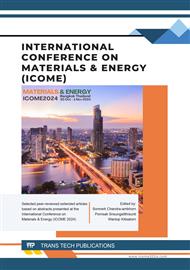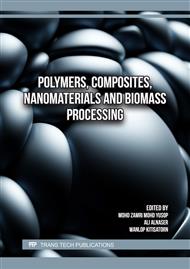[1]
T. Muringayil Joseph, S. Azat, Z. Ahmadi, O. Moini Jazani, A. Esmaeili, E. Kianfar, J. Haponiuk, S. Thomas, Case Stud. Chem. Environ. Eng., 9 (2024) 100673.
DOI: 10.1016/j.cscee.2024.100673
Google Scholar
[2]
A. Majumdar, S. Shukla, A.A. Singh, S. Arora, Resour. Conserv. Recycl., 161 (2020) 104915.
Google Scholar
[3]
N. Belkahla, N. Saidi-Amroun, M. Saidi, M. Benaissa, Int. J. Polym. Anal. Ch., 18 (2013) 15-24.
Google Scholar
[4]
H. Kiliç, D. Yilmaz, Plast. Rubber Compos., 49 (2020) 164-178.
Google Scholar
[5]
Y. Zhang, L. Ying, Z. Wang, Y. Wang, Q. Xu, C. Li, Polymer, 234 (2021) 124246.
Google Scholar
[6]
Y. Hu, Y. Wang, X. Zhang, J. Qian, X. Xing, X. Wang, Polym. Degrad. Stab., 179 (2020) 109261.
Google Scholar
[7]
J. Wang, W. Cheng, Y. Gao, L. Zhu, L. Pei, Polymers, 11 (2019) 520.
Google Scholar
[8]
T. Agnhage, A. Perwuelz, N. Behary, Ind. Crops. Prod., 86 (2016) 334-341.
Google Scholar
[9]
A.E.A. Elabid, J. Zhang, J. Shi, Y. Guo, K. Ding, J. Zhang, Appl. Surf. Sci., 375 (2016) 26-34.
Google Scholar
[10]
M.-L. Zhao, F.-X. Li, J.-Y. Yu, X.-L. Wang, J. Appl. Polym. Sci., 131 (2014).
Google Scholar
[11]
S.A. Rafiqah, A. Khalina, A.S. Harmaen, I.A. Tawakkal, K. Zaman, M. Asim, M.N. Nurrazi, C.H. Lee, Polymers, 13 (2021) 1436.
DOI: 10.3390/polym13091436
Google Scholar
[12]
J. Xu, B.-H. Guo, Biotechnol. J., 5 (2010) 1149-1163.
Google Scholar
[13]
J.N. Chakraborty, 24 - Influence of fibre and dye structures in dyeing, in: J.N. Chakraborty (Ed.) Fundamentals and Practices in Colouration of Textiles, Woodhead Publishing India2010, pp.260-271.
DOI: 10.1533/9780857092823.260
Google Scholar
[14]
Y. Kong, J.N. Hay, Polymer, 44 (2003) 623-633.
Google Scholar
[15]
T. Yokohara, M. Yamaguchi, Eur. Polym. J., 44 (2008) 677-685.
Google Scholar
[16]
Y. Deng, N.L. Thomas, Eur. Polym. J., 71 (2015) 534-546.
Google Scholar
[17]
E.A. Hassan, S.E. Elarabi, Y. Wei, M. Yu, Text. Res. J., 88 (2018) 1735-1744.
Google Scholar
[18]
Y. Xu, J. Xu, D. Liu, B. Guo, X. Xie, J. Appl. Polym. Sci., 109 (2008) 1881-1889.
Google Scholar
[19]
S. Aïnouz, J. Zallat, A. de Martino, C. Collet, Opt. Express, 14 (2006) 5916-5927.
DOI: 10.1364/oe.14.005916
Google Scholar
[20]
M.L. Di Lorenzo, R. Androsch, M.C. Righetti, Eur. Polym. J., 94 (2017) 384-391.
Google Scholar



